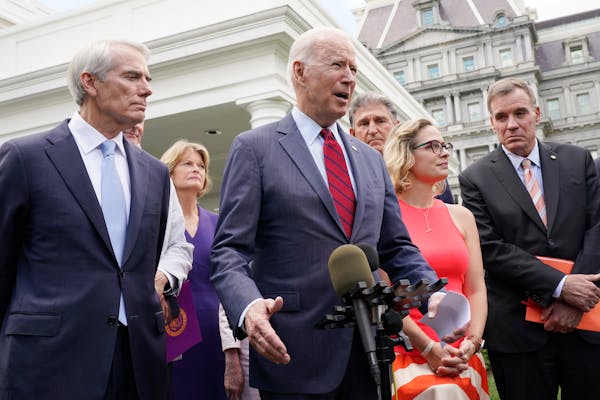Every two years, the Metropolitan Council distributes millions in federal funding for relatively small but significant transportation projects throughout the region, ranging from traffic signals to bike paths.
But this year, the regional planning body has $155 million more than usual for the work — enabling the council to double the number of projects funded with federal money — due to President Joe Biden's $1.2 trillion Infrastructure Investment and Jobs Act, which was signed into law in November 2021.
All told, some 91 projects intended to improve mobility and safety throughout the Twin Cities are receiving about $355 million in federal funds. Construction will begin next year and last through 2027.
Without the bipartisan infrastructure law, the Met Council would have received about $200 million in federal funds, enough to pay for 44 projects.
"The great thing this year is that we're able to fund a ton of projects as a result of the federal funding," said Charles Carlson, executive director of Metropolitan Transportation Services for the Met Council.
The projects require local governments and other entities receiving money to provide a local match. As Carlson noted, "It's really a way that folks can leverage scarce local dollars that can mean a significant improvement to the transportation system."
The grants are reviewed by the Met Council's little-known but influential Transportation Advisory Board (TAB), a 34-member body consisting mostly of elected officials. The full Met Council approved the grants earlier this month.
Edina Mayor Jim Hovland, who chairs the TAB, said its members "have a range of views on how transportation should operate across the spectrum." The hallmark of the board, he said, "is laying a geographic lens over the process to make sure it's fair."
But members also try to balance requests by transportation mode — whether it's traditional road upkeep, public transit or bike and pedestrian trails.
Focus on safety
The list of projects approved in this cycle is diverse. Some will fix aging roads that haven't been significantly overhauled since the 1950s, while others upgrade seemingly rudimentary infrastructure such as traffic signals; for example, the average age of some signals on Maryland Avenue in St. Paul is 47 years.
A few grants pay homage to transportation's future, including a $624,000 project by St. Paul-based HourCar that was awarded a $499,000 grant for electric vehicle charging stations in multi-family housing complexes. More than a dozen grants aim to curb carbon emissions.
Safety is a prime focus of many of the grants. Met Council officials say some 480 intersections will be improved, resulting in a projected reduction of 680 crashes. That includes the $1.7 million reconstruction of Hiawatha Avenue and E. 26th Street in Minneapolis, where the second-highest number of vehicle and bicycle crashes occur in the city.
Other grants will help overhaul busy suburban highway intersections, including an interchange at Hwy. 101 and Interstate 94 in Rogers. The work will address "unsafe weaving issues," rear-end and sideswipe crashes, and long traffic queues, according to the grant.
Some bridges judged as structurally deficient will be replaced, including a 55-year-old span on Bass Lake Road over Twin Lakes Inlet between Brooklyn Center and Crystal. The existing bridge has sections where rebar is exposed and "showing signs of rusting," the grant states.
The same is true of the Nicollet Avenue bridge spanning Minnehaha Creek and Parkway in south Minneapolis, which is slated for a $21.5 million rehabilitation — including $7 million from the feds. The span, built in 1923 and repaired 50 years later, shows signs of "cracks, concrete spalls, deteriorated concrete, and exposed/rusted reinforcement," planners noted.
The money also will help aging roadways keep up with the metro area's growing suburbs and exurbs. One example is a $3.8 million grant to improve the intersection at Hwys. 11 and 10 in Carver County, a key crossroads that links the burgeoning cities of Chaska, Victoria, Waconia and Carver.
Other projects aim to fix aging infrastructure in the urban core, including a $6 million reconstruction of Franklin Avenue in Minneapolis between Lyndale and Blaisdell avenues.
In some cases, the grants complement one another. Reconstruction of a 2-mile stretch of Rice Street in St. Paul will help when the G Line arterial bus rapid transit (BRT) line begins service. Some $25 million in federal funding was set aside in this round for arterial BRT, including the G Line, which will extend from Little Canada to the Robert Street corridor in West St. Paul.
Carlson said financing a transit project this way is "magical," using a single construction process to "leverage transformative change for the street between the transit and roadway improvements all happening at once, instead of being metered out over time."
One of several bike and pedestrian trails approved includes the first phase of the Point Douglas Regional Trail from Bailey Road in Newport to Battle Creek Regional Park, with the planned endpoint in Indian Mounds Regional Park in St. Paul. The nearly $7 million project will bolster safety by diverting trail users off the street, said Paul Sawyer, a St. Paul Parks and Recreation grants administrator.
Sawyer called federal funding for the trail "transformational." It will give East Side bike commuters and residents, he said, "a safe place to run, walk their dogs, meet up with friends and neighbors for a walk, or go for a bike ride in the scenic river valley."

Want to share info with the Star Tribune? How to do it securely

'Safe recovery sites' would offer syringes, naloxone and more to people using drugs. The plan could be in peril.
New Minnesota GOP leaders seek peace with party's anti-establishment wing

Who is Republican Lisa Demuth, Minnesota's first House speaker of color?

